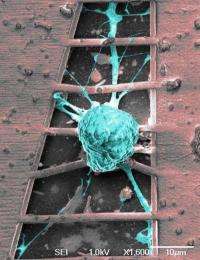Understanding the human neurosystem: From the brain of a locust

In the human brain, mechanical stress -- the amount of pressure applied to a particular area -- requires a delicate balance. Just the right force keeps neurons together and functioning as a system within the body, and proper nerve function is dependent on this tension.
Now researchers at Tel Aviv University say that mechanical stress plays an even more important role than medical science previously believed. Their research has the potential to tell us more than ever before about the form and function of neuronal systems, including the human brain. And they've used the common locust to prove it.
Prof. Amir Ayali of Tel Aviv University's Department of Zoology, with Prof. Yael Hanein of the School of Electrical Engineering and Prof. Eshel Ben-Jacob of the Department of Physics, has successfully cultured cells taken from the desert locust to delve deeper into the workings of the mammalian neurosystem. Their most recent discovery, he says, is that mechanical stress plays a pivotal role not only in the development of the brain, but also its function.
Recently published in several journals including Biophysical Journal and Nanotechnology, this research demonstrates that mechanical stress is instrumental in several key phenomena in neuronal development. Once a neuron has developed, explains Prof. Ayali, it is attracted to and then attaches to another neuron, which pulls it to the appropriate place within the neurosystem. "This tension is crucial for making the right connections," he says.
A neuron system in a dish
According to Prof. Ayali, insect cells provide a unique window into the world of neurons because they're easier to work with than human cells. Large enough to culture, Prof. Ayali and his fellow researchers harvested insect neurons and allowed them to regenerate, then built an in vitro nervous system in a dish. The team was then able to follow each single cell optically, watching how they regenerated and recording their electrical activity.
Most importantly, the team was able to observe the neurons form a network. A key feature, Prof. Ayali says, is mechanical tension. As the neurosystem develops, some cells are eliminated, while others are stabilized and preserved. Cells that successfully connect with one another maintain this connection through mechanical stress. This tension draws cells to their destined locations throughout the neurosystem. As neurons develop, they migrate to the appropriate location in the body, and it's mechanical stress that draws them there.
A meeting of the minds
Although the researchers' choice of insect cells for their investigation is unorthodox, Prof. Ayali says that the benefits are tremendous. The cells are basic enough to be applicable to any system, including the human neurosystem, he notes. If it were not for the large size and low density that insect cells provide, the team would not be able to follow individual cells and track the connections they make. "We're looking at simple phenomena that apply generally," he says. "The development from single cells to groups of clusters is common to every kind of neuron."
The research is unique in more ways than one. Prof. Ayali emphasizes that this project exhibits a truly interdisciplinary approach to neuroscience. The project includes researchers from numerous scientific fields, including zoology, electrical engineering and physics.















